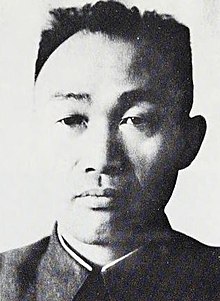Kim Chaek
Kim Chaek | |
|---|---|
 Kim Chaek | |
| Vice Premier of the Cabinet | |
| In office 9 September 1948 – 31 January 1951 | |
| Premier | Kim Il-sung |
| In office 9 September 1948 – 31 January 1951 | |
| Premier | Kim Il-sung |
| Preceded by | Post established |
| Succeeded by | |
| Personal details | |
| Born | 14 August 1903 Sŏngjin, , North Hamgyong Province, Korean Empire |
| Died | 31 January 1951 (aged 47) |
| Citizenship | North Korean |
| Nationality | Korean |
| Children | |
| Occupation | North Korean general and politician |
| Awards | North Korea's National Reunification Prize |
| Military service | |
| Allegiance | Korean People's Army |
| Years of service | 1945–1951 |
| Commands | KPA front commander |
| Battles/wars | See battles |
Kim Chaek (Korean: 김책; Hanja: 金策, 14 August 1903 – 31 January 1951) was a North Korean National resistance activist, general and politician. His real name was Kim Hong-gye (김홍계, 金洪啓).
Life[]
Kim Chaek was born in Sŏngjin, North Hamgyong, Korea, in 1903. He and his family fled to Manchuria after Korea was colonized by Japan. In 1927, Kim joined the Communist Party of China and the Anti-Japanese movement to oppose the Japanese occupation. He was imprisoned for his resistance activities. After his released from prison, Kim joined the Northeast Anti-Japanese United Army in 1935 and fought alongside with Kim Il-sung. He fled to the Soviet Union to escape the Japanese conquest of the partisans in 1940. He lived in Khabarovsk where he met with Kim Il-sung and formed the 88th Special Brigade. After the Soviet invasion of Manchuria, he returned to Korea along with the Soviet Army in 1945. On September 9, 1948, the Democratic People’s Republic of Korea was established, Kim became the industry minister and deputy prime minister under Kim Il-sung. He was appointed number 2 Committee Vice Chairman in the Korean Workers Party. In the Korean War, he was a commander of the North Korean troops on the front lines.
Kim was purged when he was found responsible for the failure at the Inchon landing. He died in January 1951 after an American military air raid bombing. Some scholars believe that his death was an assassination after a power struggle, and caused by gas poisoning rather than an air strike.[1]
Posthumous honours[]


After his death, Kim Chaek's birthplace , combined with the neighboring city of Songjin, was formally renamed to Kim Chaek City to commemorate his life and accomplishments.[2] The Kim Chaek University of Technology, Kim Chaek Iron and Steel Complex, and Kim Chaek People's Stadium[3][user-generated source] are also named after him. The stadium is located at 40°41'0"N 129°11'47"E.
He was posthumously awarded North Korea's National Reunification Prize in 1998.[4]
Work[]
- Song "Song of General Kim Il-sung" 《김일성장군의 노래》
- Feature-length epic "Mt. Paektu" 《장편 대서사시 백두산》
References[]
- ^ Lim Un (1982). 北朝鮮王朝成立秘史: 金日成正伝 [The Founding of a Dynasty in North Korea: An Authentic Biography of Kim II-song] (in Japanese). 自由社. OCLC 674262502.
- ^ Koehler, Robert (2004-09-15). "Kim Il-sung's family and North Korean place names". The Marmot's Hole. Archived from the original on 2008-10-11. Retrieved 2009-04-17.
- ^ "Kim Chaek People's Stadium - Kimchaek (Formerly Sŏngjin)".
- ^ "National Reunification Prize Winners", Korean Central News Agency, 1998-05-07, archived from the original on 2013-06-02, retrieved 2012-09-13
- Korea, a century of change by Jürgen Kleiner page 275
- Korea Web Weekly Remembering Kim Chaik
- Kim Jong Il Biography. Pyongyang: Foreign Languages Publishing House for Literature, 2005.
- 1903 births
- 1951 deaths
- People from Kimchaek
- Government ministers of North Korea
- North Korean generals
- North Korean military personnel of the Korean War
- Recipients of the National Reunification Prize
- Military personnel killed in the Korean War
- Deaths by American airstrikes
- Purges in North Korea
- Members of the 1st Central Committee of the Workers' Party of North Korea
- Members of the 2nd Central Committee of the Workers' Party of Korea
- Members of the 2nd Political Committee of the Workers' Party of Korea
- Members of the 2nd Standing Committee of the Workers' Party of Korea
- Members of the 1st Supreme People's Assembly